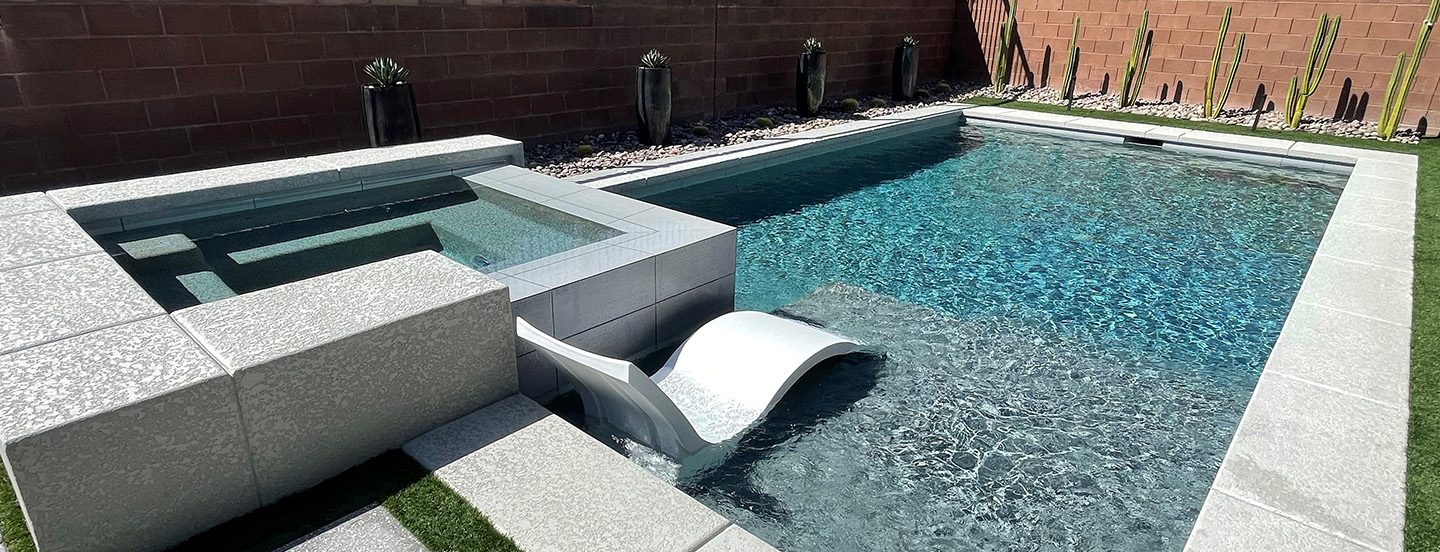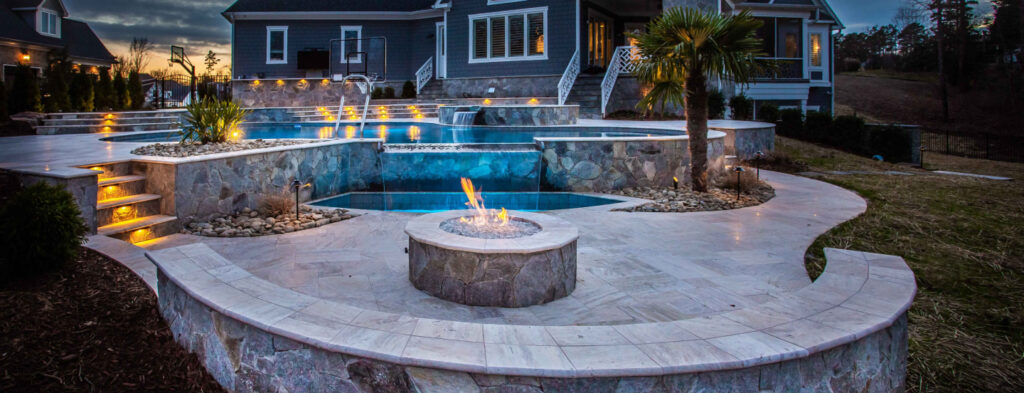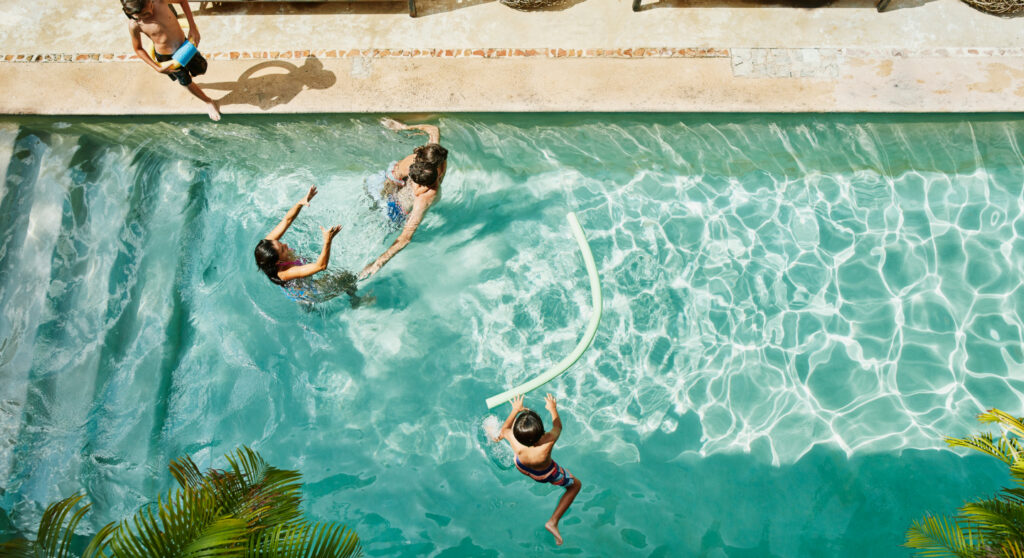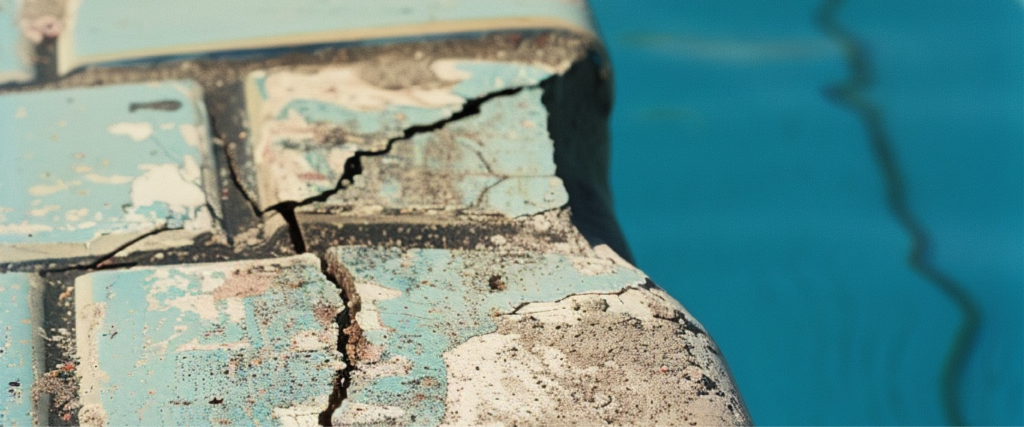When planning a new pool, a variety of factors will impact both the installation costs and future expenses.
1. Pool Building Materials
When building a new pool in Austin, you’ll have three primary material options, each with its own advantages and considerations. The right choice depends on your budget, priorities, and long-term goals for your pool.
- Vinyl: Vinyl pools are constructed using plastic polymer or steel with a vinyl liner, making them the most affordable option. However, they’re the least durable, as the liners are prone to tears and scratches, and must be replaced roughly every 10 years.
- Fiberglass: Fiberglass pools are pre-manufactured shells that are delivered and installed as a single unit. This makes them the quickest type of pool to install. They fall in the middle range for cost and maintenance, offering a lifespan of about 25 years. Fiberglass pools are known for their smooth surfaces, which resist algae growth and minimize maintenance efforts.
- Concrete: Also called gunite pools, concrete pools are the most customizable option, allowing for unique shapes, features, and designs. They’re also the most durable, with lifespans ranging from 50 to 100 years. They’re an excellent long-term investment for those looking for a highly personalized pool that stands the test of time.
2. Pool Design Type
The design of your pool is a major factor in pricing. Here are some common options and their impacts on cost:
- Inground Pools: Customizable and durable, with a higher upfront cost due to excavation and construction.
- Above-Ground Pools: They are quicker to install and are in the middle range for cost and maintenance.
- Plunge Pools: Compact and relaxing, these pools can be more cost-effective but can include premium features.
- Freeform Pools: Custom shapes and natural designs can raise costs due to additional materials and labor.
- Swim Spas: Combining a pool and spa, swim spas are smaller and generally more affordable but may come with added features.
3. Pool Size and Depth
Larger and deeper pools require more materials and labor, which increases their overall cost. Most inground pools range in size from 10×20 feet to 20×40 feet, with depths typically between 5-8 feet. Your pool builder will evaluate your backyard and recommend options that align with your preferences, property layout, and local regulations.
4. Terrain and Soil Conditions
The extent of site preparation needed to build your pool will also affect the overall cost of your pool’s build. Austin’s soil consists of limestone and expansive clay, which can be difficult to excavate. Rocky patches and uneven terrain are common in some areas, requiring specialized equipment or more labor for excavation. Site preparation may also involve leveling the ground, removing trees, or relocating utilities, which can further affect the overall price. Your pool builder will evaluate your property’s specific conditions to determine the best approach and any additional costs involved.
5. Additional Pool Features
When building a pool in Austin, the features you select can greatly influence the overall cost. Luxury additions like spas, color-changing LED lighting, cascading fountains, in-pool seating, fire features, and tanning ledges typically come with higher price tags. Safety upgrades, including fencing, safety nets, or alarms, add another layer of cost but are often essential for peace of mind. These choices all contribute to the final price, depending on the level of customization you want.
6. Utilities
In Austin’s warm climate, keeping your pool filled and maintained is essential, but it does come with costs. Some builders like Anthony & Sylvan will cover the cost of filling your pool, but otherwise, filling your pool with water from a hose can take up to 72 hours and the cost will depend on your city’s water rate. Afterward, maintaining clean and balanced water will require regular filtration and cycling, which increases water and electricity usage. Austin residents with saltwater pools should also budget for ongoing purchases of salt bags to maintain proper levels.
7. Local Regulations
In Austin, Texas, pool construction is subject to local permits and regulations, which vary by county. Most requirements focus on fencing and water discharge. State law mandates that residential pools be enclosed by a barrier at least four feet high, with no gaps or openings wider than four inches. Chain-link fencing is prohibited, and pool gates must be self-closing and self-latching to enhance safety and ensure compliance.
At Anthony & Sylvan Pools Austin, we’re well-versed in all local regulations and handle the permitting process to ensure compliance. However, permit costs and requirements can vary based on location. We recommend checking with your local builder for the most accurate information.
8. Taxes
In Texas, adding a pool to your property can increase its value, which may result in higher property taxes. The extent of the increase depends on how the pool is assessed by your county’s appraisal district and the type of pool you build. In Austin, for instance, counties may classify above-ground and smaller pools differently than in-ground pools when calculating value. If the pool is being installed for medical reasons and meets specific IRS requirements, you might qualify for a tax deduction on both the installation and ongoing maintenance costs.
9. Insurance
When you add a pool to your property, you’ll need to update your homeowner’s insurance to reflect the new addition. This typically leads to an increase in premiums, as the policy will need to cover potential damage to the pool and liability protection for accidents or injuries. The exact cost will depend on your insurance provider and the type of pool you install. It’s a good idea to contact your insurer to understand how adding a pool will affect your coverage and costs.
10. Maintenance
Owning a pool in Austin requires regular maintenance, with the particular costs depending on the type of pool you build and how regularly it is used. Chlorine pools need weekly chemical replenishment, while saltwater pools require salt refills and occasional salt cell replacement every 3 to 7 years. Filters (sand, cartridge, or DE) should be cleaned monthly and replaced every 1 to 5 years. Pool pumps last 8 to 12 years, but repairs may be needed sooner. Additionally, concrete pools may require resurfacing every 8-20 years depending on the type of finish, and vinyl liners need replacement every 5 to 10 years.









